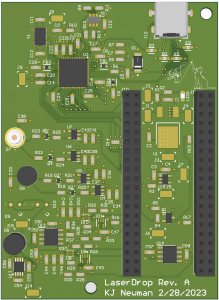- Risks
- With the complete PCB design, we removed some of the planned backup plans since they were not feasible. The big one is that we were planning on leaving some extra DNP pads for more green photodiodes in case our photodiodes are not strong enough. However, there is slightly more risk now since we had to remove this to make layout work.
- We noticed that the FPGA board lists some pins as clock pins. The Datasheet does not describe what this means. This is 2 pins from the FTDI chip and the 2 IR laser controlling pins. If this ends up being an issue, we can accommodate it by using an interface with the FTDI chip that does not use those pins (fast serial) and by testing that the IR laser pins operate at high enough speed.
- Design Changes
- Our PCB will be much smaller than the FPGA board rather than a copy of it. This is because the parts fit on a much smaller footprint, and making it smaller makes buttons and LEDs on the FPGA board accessible, and it will be easier to make sure the boards fit together.
- Updated Schedule
- In terms of schedule, software developments (Roger) were impacted by inability to develop software for hardware that had not been fully finalized. We have instead begun working on sender implementation as well as a preliminary UI interface to input text files for sending in order to be productive within the schedule constraints.
- No changes have been made to the hardware schedule as the PCB and part orders went out on time
- Progress
- PCB design is complete! Our PCB and all components for it have been ordered and should arrive by the time we return from spring break.
- Sender implementation for the bitwise hamming encoding of files has been implemented
- We completed our design report paper
- PCB design is complete! Our PCB and all components for it have been ordered and should arrive by the time we return from spring break.
- New Tools
- We will need to learn to use FT_PROG to program the EEPROM to save settings for our FTDI chip
- We will need to experimentally identify the best way to view the infrared laser for debugging and testing. We currently plan on using the front-facing camera from our phones, as they typically do not have IR-cut filters. However, this may not work. In that case, we will need to learn to use an IR camera to measure it.

Anju Ito, Roger Lacson, and KJ Newman
